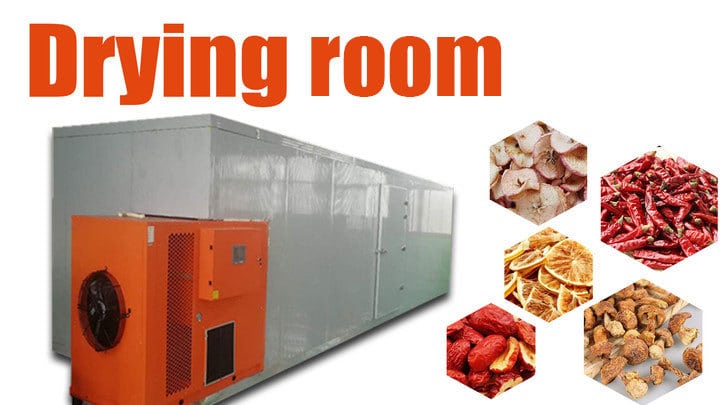
Drying room, also known as a box-type dryer or drying baker. The drying room is a sealed, high-efficiency drying system that uses a heating system combined with hot air circulation to evenly distribute heated air to the materials, achieving fast and uniform dehydration.
Both the chamber and trays are made of high-quality stainless steel, offering excellent corrosion resistance, durability, and compliance with food hygiene standards. It is also equipped with an automatic control system for easy and intelligent operation.
With a drying capacity ranging from 300 to 8000 kg/time, the machine supports multiple heating options, including coal, electric, and heat pump systems to meet different processing needs.
This versatile equipment is widely used for drying vegetables, fruits, meat products, tobacco, leather, grains, fabrics, fertilizers, paper, hardware, industrial goods, chemicals, sludge, and more, maximizing utility and efficiency.
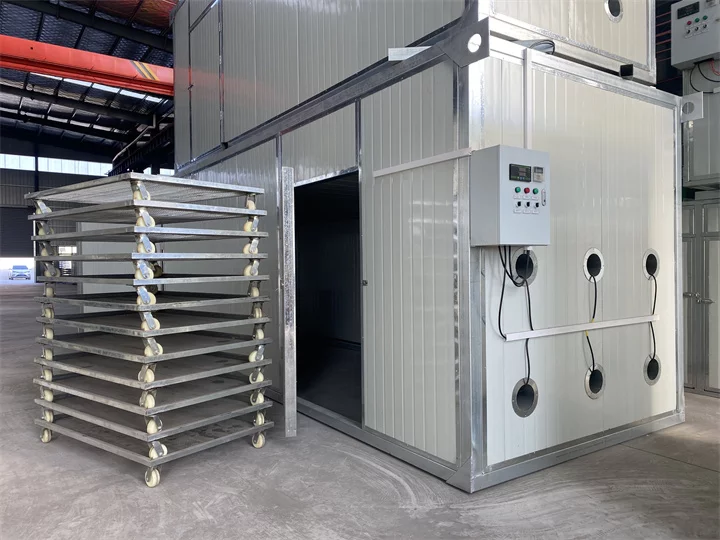
What are the advantages of drying room?
High drying efficiency
Adopts a sealed structure combined with forced hot air circulation. Supports continuous or timed batch drying, saving drying time and increasing productivity. Compared with natural sun drying or traditional methods, production capacity can be increased by more than 30%.
Stable drying quality
Equipped with an automatic temperature and humidity control system to ensure uniform drying of materials without deformation or discoloration.
Strong adaptability
Suitable for a wide variety of materials, including agricultural products, aquatic products, medicinal herbs, wood, and industrial parts.
Energy-saving & environmentally friendly
Multiple heating energy sources are available, such as heat pumps, electricity, and natural gas, supporting clean and low-carbon production.
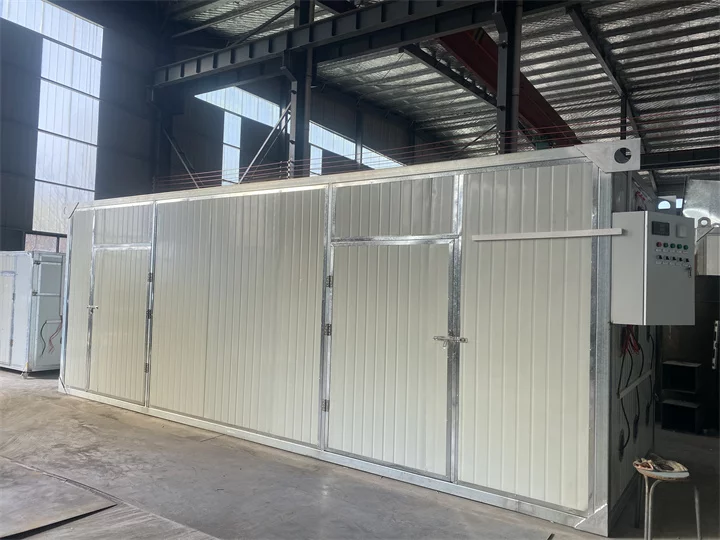
High degree of automation
Can be equipped with a PLC or touch screen control system to automatically manage heating, temperature, dehumidification, and timing functions.
Hygienic and safe
No emissions of waste gas, wastewater, or solid waste during operation. Optional food-grade stainless steel interior meets GMP standards.
Flexible structure, customizable
Size, capacity, number of trays, and other configurations can be customized based on production needs.
Compact footprint & easy installation
Modular design with a small footprint allows for quick assembly and convenient installation.
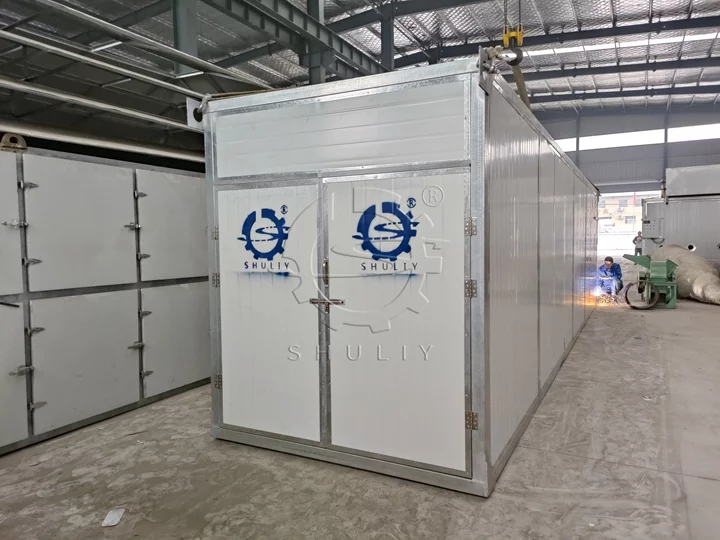
Applications of the chamber dryer machine
The main raw materials in the commercial drying room are fruits and vegetables, fungi, Chinese medicinal materials, seafood, crops, and some chemical products. It can also be customized according to the user’s demands for different products.
The main kinds of raw materials
- Fruit: Almonds, jujubes, peanuts (with shells), walnuts, papaya slices, hawthorn slices, apple slices, lemon slices, kiwi, mulberries, etc.
- Vegetables: Asparagus, carrot, kidney beans, lentils, eggplant, red pepper, pepper, cucumber slices, mushrooms, shiitake mushrooms, ginger slices, garlic slices, etc.
- Chinese medicinal materials: Honeysuckle, nasturtium, burdock, ginseng, mulberry, etc.
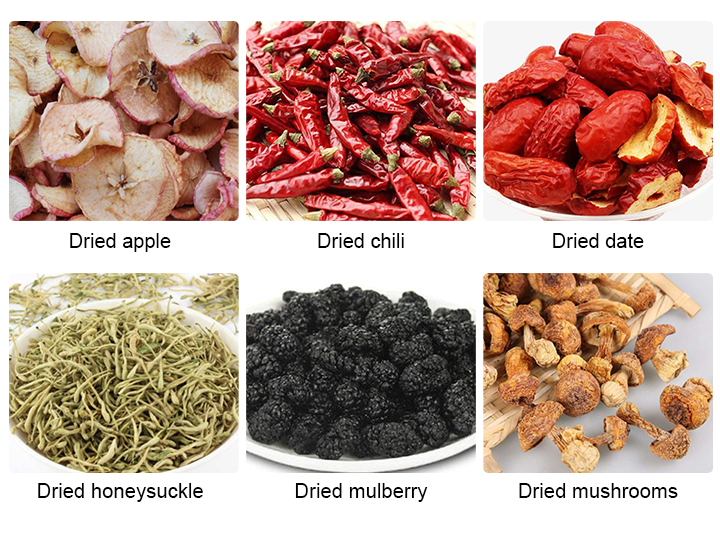
Technical parameters of the box type dryer
| Model | Dimensions(mm) | Drying crews | Quantity of drying material (times/kg) |
| SL-2 | 4000*1860*2500 | 2 | 300-600 |
| SL-4 | 6000*1860*2500 | 4 | 500-1000 |
| SL-6 | 7200*2300*2500 | 6 | 800-1500 |
| SL-8 | 8500*2300*2500 | 8 | 1000-2000 |
| SL-10 | 10000*2300*2500 | 10 | 1200-2500 |
| SL-12 | 8500*3300*2500 | 12 | 2500-4000 |
| SL-18 | 8500*5000*2500 | 18 | 4000-6500 |
| SL-24 | 12000*5000*2500 | 24 | 5000-8000 |
At the Shuliy Drying Machinery factory, we have 12 models of heat drying equipment with different capacities for sale. The smallest machine size is 4000x1600x2500mm, and the largest size is 12000*5000*2500mm. Customers can choose according to their needs. Do you need this efficient food drying equipment? If yes, please feel free to contact us.
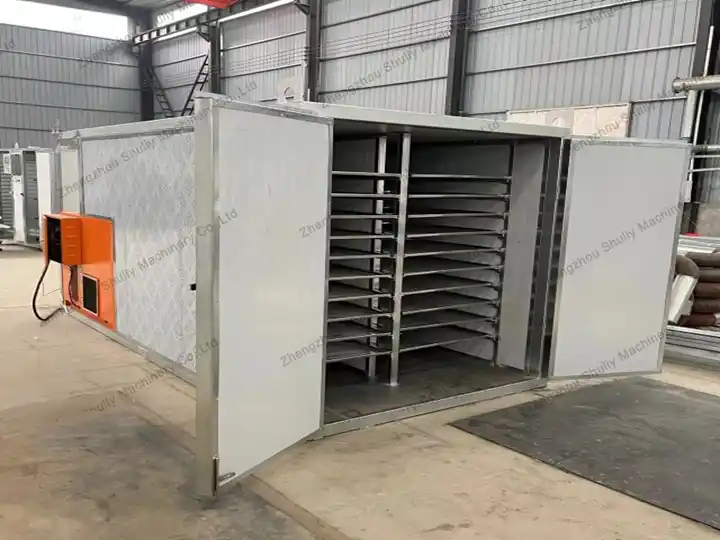
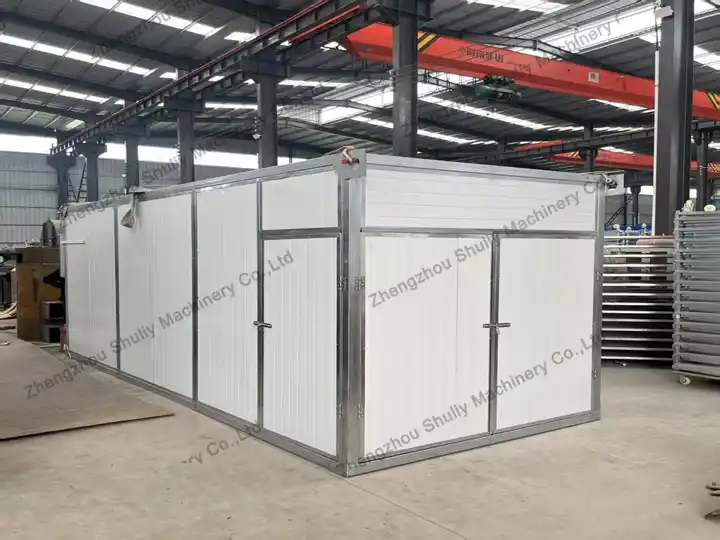
What heat sources are used in the drying room?
Air source heat pump
An air source heat pump absorbs heat from the surrounding air, compresses it to a higher temperature, and then transfers the heat to the drying room for heating.
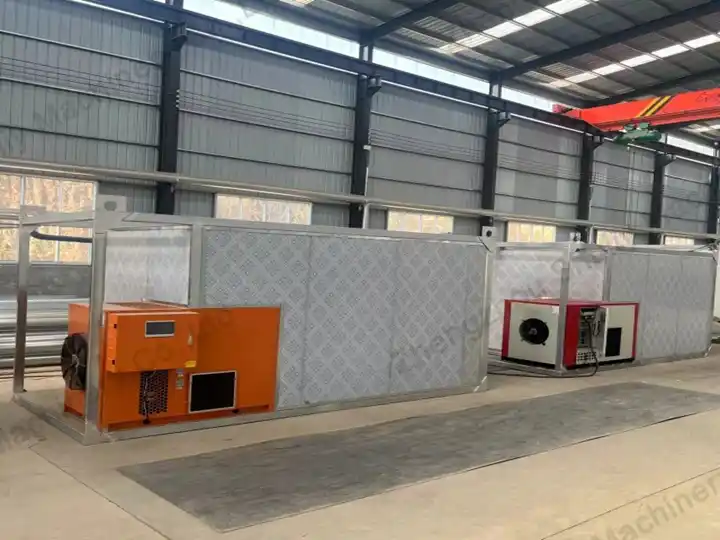

Electric heating
Electric heating uses electricity to heat the electric heating tubes directly. The tubes transfer heat to the air or drying medium in the drying room, heating the materials and completing the drying process.
Sulfur-free coal heating
Sulfur-free coal heating uses coal with very low sulfur content as fuel. The coal burns to release heat, which warms the air or hot water in the drying room to dry the materials. Since the coal contains almost no sulfur, it produces little sulfur dioxide, making it more environmentally friendly. It is suitable for large-scale drying operations that require high temperatures.
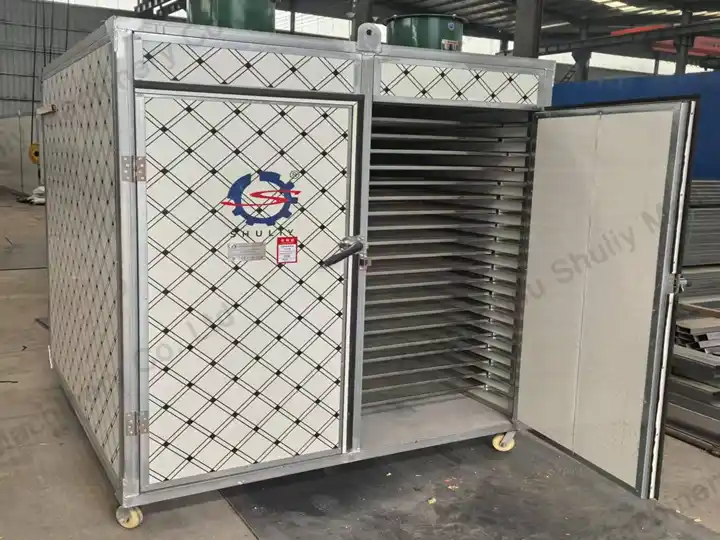
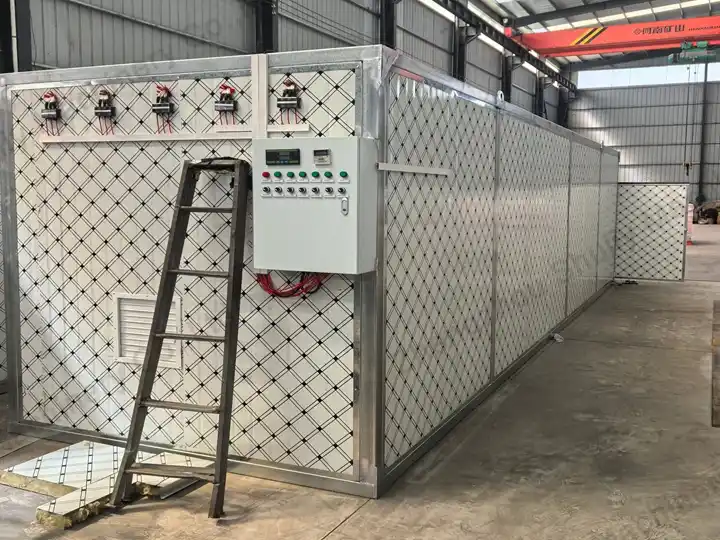
Hybrid energy supply – coal and electricity
This multi-functional hot air furnace can flexibly use electricity, fuel oil, natural gas, or coal as the heat source. With high-efficiency finned heat exchangers and an automatic temperature control system, it provides efficient and controllable drying and heating.
Three heat sources comparison
| Comparison | Air Source Heat Pump | Electric Heating | Sulfur-Free Coal Heating |
|---|---|---|---|
| Working principle | Compresses air to absorb heat and warm the drying air | Converts electricity directly into heat for air | Burns low-sulfur coal to generate heat for air |
| Efficiency | High, 1 kW electricity produces 3–6 kW heat | Low, 1 kW electricity produces 1 kW heat | Medium, efficiency depends on combustion |
| Environmental dependency | Efficiency drops slightly in low outdoor temperature | Not affected by environment | Requires stable fuel supply |
| Investment cost | High | Low | Medium |
| Operating cost | Low | High | Fuel cost is low |
| Environmental impact | No combustion, no emissions | No emissions, but high electricity use | Produces smoke, but low sulfur emissions |
| Temperature control | Precise control | Precise but may overheat locally | Adjustable, but less precise |
Composition of the drying baker
This box-type dryer’s main body is a steel structure; the whole equipment is composed of the drying box, internal circulating fans, trays, electromechanical programming automatic control devices, a dehumidifying fan, a heat source, and so on.
- The drying box: The outside box is a large oven, it was made of high-temperature-resistant rock wool, and the frame is supported by an 80*40 galvanized square pipe.
- Automatic control device: The equipment adopts PLC automatic control, which can achieve temperature and humidity automatic control. The equipment will automatically stop when it reaches the required temperature and humidity.
- Circulating fan and dehumidifying fan: Both are driven by High-power fans, hot air circulation devices, and moisture discharge devices.
- Automatic control device: The system adopts a PLC full automatic control, and the dryer equipment can realize the automatic control of temperature and humidity. The system will auto-stop when the drying temperature and humidity meet the requirements of the material.
Heating source: The heating way includes electric heating, oil burning, coal burning, natural gas burning, air energy heat pump , etc. (The heat source can be customized) .
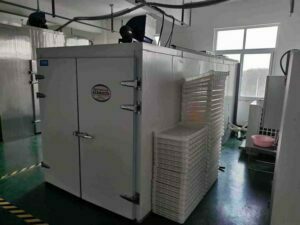
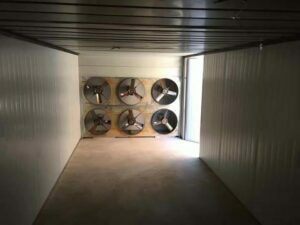
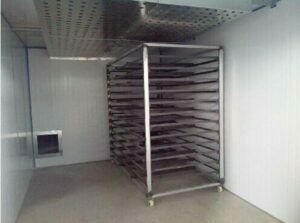
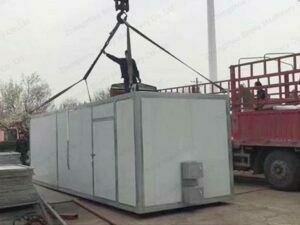
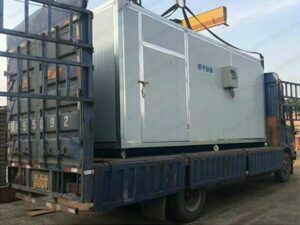
How does the drying room work?
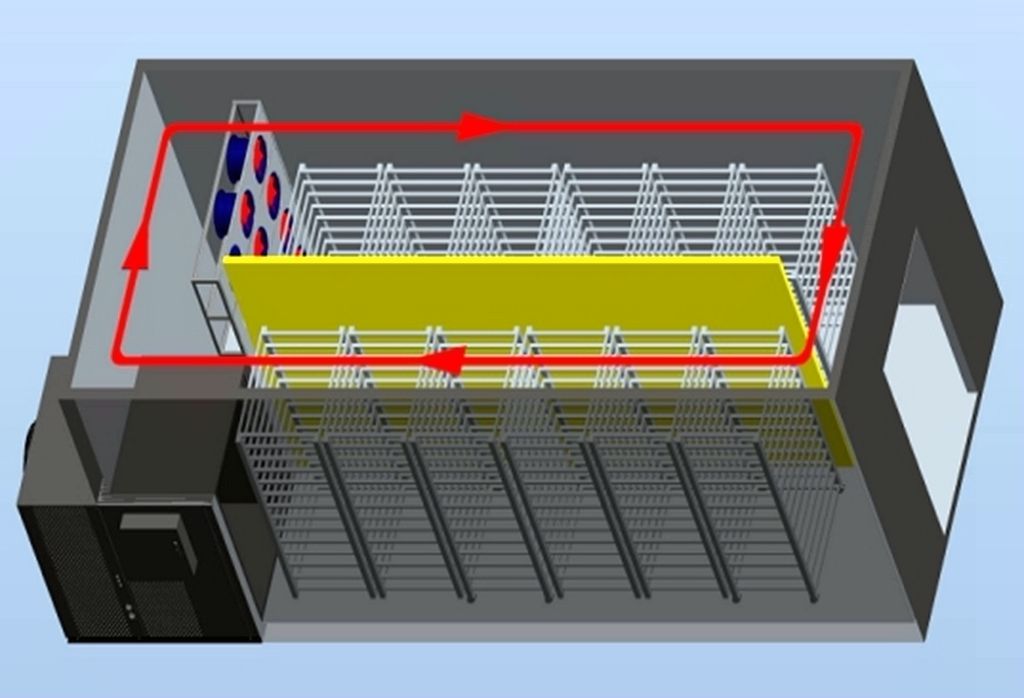
After laying the raw material on the Multi-layer raw material board, put it into the drying room by conveyor system or manually.
The circulating fans’ and dehumidifying fans’ running speed can be adjusted freely according to the temperature and humidity of the material.
The hot air generated by the heat source will be sent to the drying room by the circulating fan, part of the heat will be absorbed by the material, and the other part will form water vapor will be discharged from the dehumidifying fan to achieve the purpose of drying.
Drying room delivery case
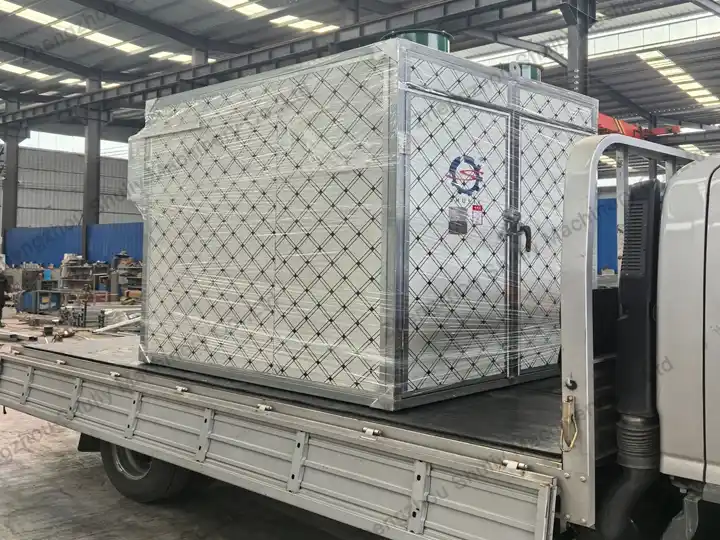
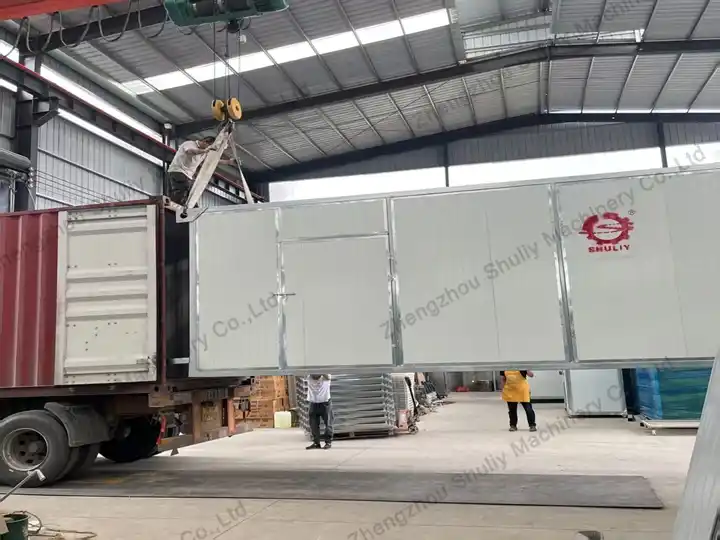
Drying solution example – fabric drying in a textile & dyeing factory
Fabrics come from a textile and dyeing factory. The drying solution should consider post-dye moisture content, fabric material, dye stability, and temperature sensitivity. Assuming 10 tons of fabric need to be dried per day, the example solution is as follows:
| Item | Value (Recommended / Adjustable) |
|---|---|
| Raw material | Dyed fabrics (grey cloth / finished fabric) |
| Capacity | 10,000 kg per batch (adjustable based on actual needs) |
| Initial moisture w1 | 50–70% (wet basis, depending on fabric absorption) |
| Final moisture w2 | ≈10–12% (wet basis) |
| Inlet temperature t0 | ≈25 ℃ |
| Drying temperature t1 | 50–65 ℃ (protect dye color, early stage) → 55–60 ℃ (moisture balance, later stage) |
| Exhaust temperature t2 | ≈55–60 ℃ |
| Heating method | a. Air source heat pump b. electric heating c. sulfur-free coal hot air (steam or gas optional) |
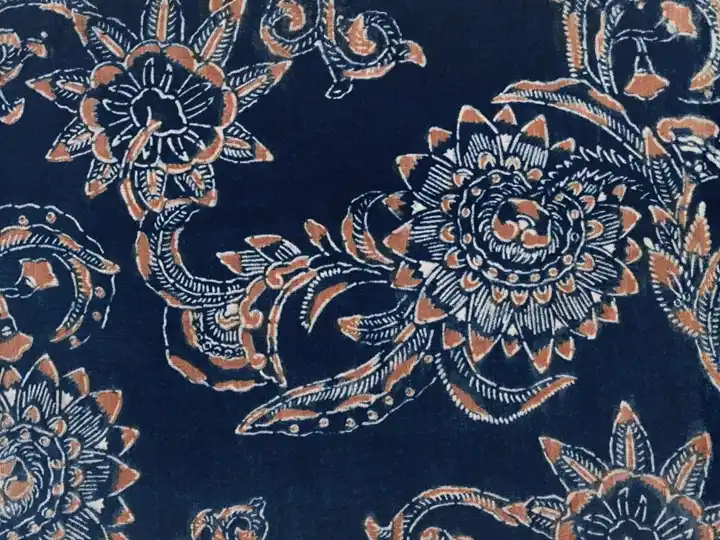
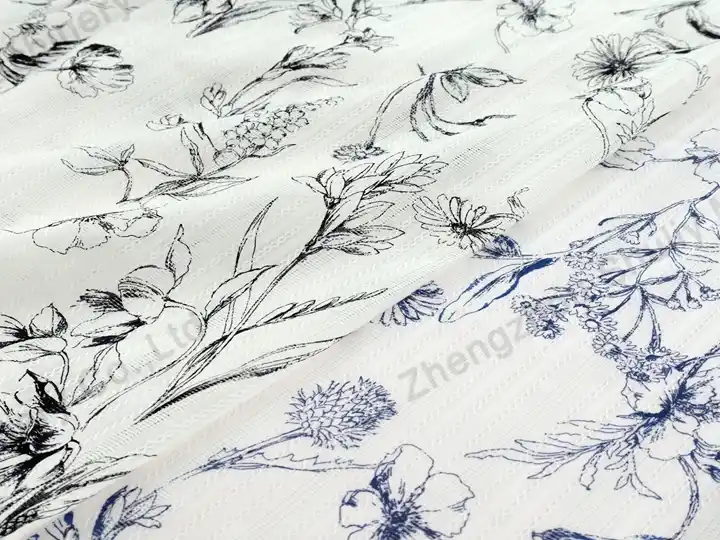
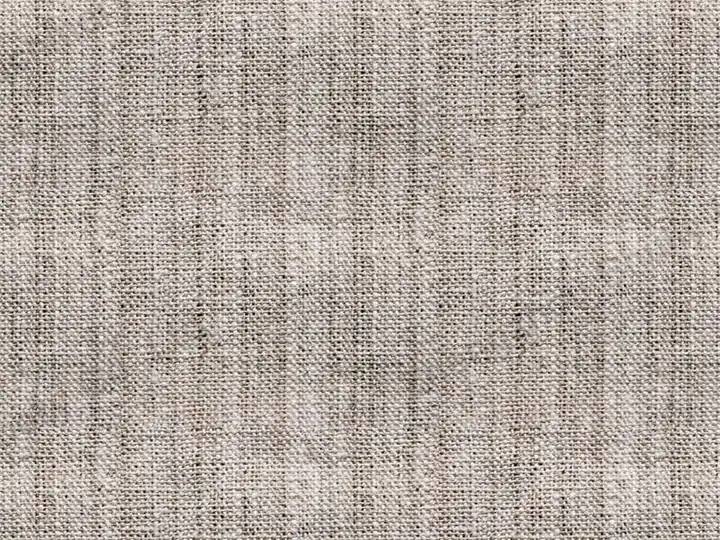
Key Heat Balance (Example: 10,000 kg Fabric)
- Dry fabric weight: ≈ 3,000–4,000 kg
- Water to be evaporated: ≈ 6,000–7,000 kg
- Estimated total heat requirement (including 15% system loss): Q_total ≈ 500,000–700,000 kcal per batch
Customer-friendly Explanation
To dry 10 tons of dyed fabric, about 6–7 tons of water need to be evaporated per batch, requiring approximately 500,000–700,000 kcal. This can be supplied by an air source heat pump, electric heating, or sulfur-free coal hot air, ensuring even drying and stable fabric color.
Equipment Selection Recommendations
Option A: Model SL-188 (Single Machine, Two Drying Runs)
- Single batch capacity: 4,000–6,500 kg
- Drying runs: 2 (first for main drying, second for finishing)
- Drying time per run: ≈ 5–6 hours (depends on fabric thickness and moisture)
- Airflow: 2–3 m/s for uniform hot air circulation
- Automatic temperature and humidity control to prevent shrinkage or color variation
Option B: Two SL-128 Machines in Parallel
- Each run dries 4,000 kg × 2 → second run dries the remaining 2,000 kg
- Shorter total drying time, suitable for fast production needs
F&Q
What materials can the drying chamber handle?
The drying chamber is suitable for a wide range of materials, including fruits, vegetables, herbs, seafood, meat, grains, textiles, leather, and industrial products. It can also be customized for special materials such as pharmaceuticals or chemicals.
What heating methods are available?
We offer several heating options:
* Air source heat pump – energy-saving and eco-friendly.
* Electric heating – clean and easy to operate.
* Low-sulfur coal heating – suitable for high-temperature, large-scale drying.
* Mixed heating system – combines coal, electricity, gas, or diesel for flexibility.
What is the drying capacity range of the machine?
The drying capacity ranges from 300 kg/h to 8,000 kg/h depending on the model. We offer 12 models from SL-2 to SL-24, covering both small and large-scale production needs.
What are the advantages of using a box-type dryer compared to natural drying?
Compared with traditional sun drying, the box-type dryer provides:
1. Over 30% higher drying efficiency
2. Uniform and stable drying quality
3. All-weather operation
4. Better hygiene and less contamination
How are temperature and humidity controlled?
The dryer is equipped with an automatic PLC or touchscreen control system that monitors and regulates temperature and humidity in real-time. The system automatically stops heating when preset values are reached, ensuring consistent drying quality.
What material is the drying chamber made of?
The inner chamber and trays are made of high-grade stainless steel, resistant to corrosion and high temperatures, and compliant with food hygiene and GMP standards.
Can the machine be customized?
Yes. We offer customized designs for size, tray quantity, material, heating source, and control system according to the customer’s processing needs and available space.
How energy-efficient is the air source heat pump drying system?
The air source heat pump can produce 3–6 kW of heat for every 1 kW of electricity consumed, making it one of the most energy-efficient and eco-friendly options available.
How long does the drying process take?
Drying time varies based on the material type, moisture content, and temperature settings. For example:
* Fruits and vegetables: 4–8 hours
* Seafood and meat: 8–12 hours
* Textiles: 5–6 hours per batch
How is the equipment installed and maintained?
The dryer adopts a modular structure that can be easily assembled on-site. Routine maintenance mainly includes:
1. Cleaning air filters and trays
2. Checking fan operation
3. Inspecting temperature sensors and controllers
4. No complex maintenance or special tools are required.
